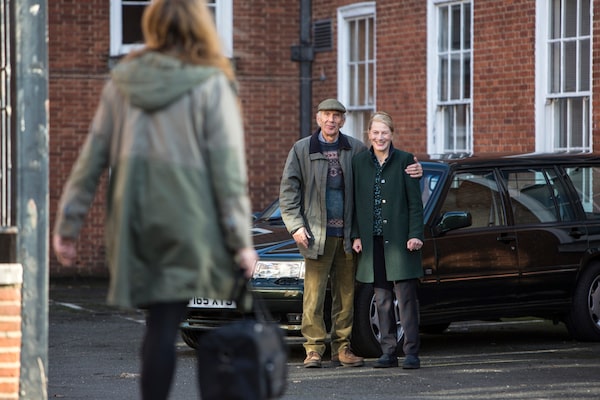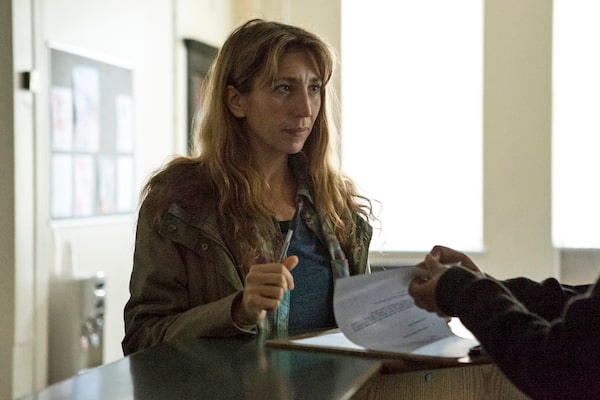
The drama-mystery-comedy follows Miri Matteson, who is re-entering the real world after an 18-year prison sentence.Luke Varley/Courtesy of SHOWTIME
The other day, yours truly read somewhere that Google has a “chief happiness officer,” and that blogging about happiness is an inevitable online hit. You could say that happiness is a specifically American racket. Other countries and cultures give more meaning to, and cultivate, melancholy.
Back to Life (Sunday, Crave, 11 p.m.) is about melancholy and magnificently so. It’s one of the strongest series of the year, and all the advance praise is justified. It is barely definable by genre-type, being comedy, drama and mystery. It’s also about happiness and the necessity of being upbeat sometimes, no matter what bricks are thrown at you.
The person who is relentlessly upbeat is the central figure, Miri Matteson (Daisy Haggard). When we meet her, she’s just been released from jail after serving 18 years for a crime that isn’t revealed until several episodes have unfolded. But you are very aware that she didn’t serve 18 years for a minor offence. Miri goes from prison to living at home in the small, seaside town where she grew up and the crime occurred. She wants to live with her parents for a while, get a job and move on with her life. She’s very determined and optimistic about it, even when the words “psycho bitch” are spray-painted on the wall of her parents’ home and someone throws a brick through a window at her when she actually lands a job.

Miri wants to live with her parents for a while in the small seaside town where she grew up, get a job and move on with her life.Luke Varley/Courtesy of SHOWTIME
What’s odd about the series is the tone. It’s very, very funny at times. Her parents, Caroline (Geraldine James) and Oscar (Richard Durden), have changed while she was in prison and have secrets of their own. They’ve developed habits and fixations to get through their own notoriety. Miri, meanwhile, wants to be happy. Or a least have a day of pleasantness. She is unfazed by the animosity aimed at her. In fact, she is more discombobulated by how the world has changed. The pop stars who feature on her bedroom wall – Prince, George Michael and David Bowie – are dead. Her Sony Walkman is an antique. She’s not all that sure how the internet works – she’s warned against Googling her own name – and is the only person in town who doesn’t have a mobile phone.
While it can be hilarious – every supporting character is presented as well defined but eccentric – there is also gloom. Miri is mostly polite and cheerful, but hardly anyone is willing to forgive or forget. Also, there’s a guy stalking her, a true-crime specialist who wants her to tell the true story of the incident that got her jailed. She cannot escape the crime. And when hilarity meets gloom, there sits melancholy.

While it can be hilarious, there is also gloom. Miri is mostly polite and cheerful but hardly anyone is willing to forgive or forget her crime.Luke Varley/Courtesy of SHOWTIME
From the producers of Fleabag and written by Haggard with Laura Solon, the six-episode series (to air on Sunday) is an absolute gem. At times droll, farcical, whimsical, surreal, but always gentle, it doesn’t have a single false note. It is part of a batch of unusually strong and genre-smashing content recently from Britain, most of it created by women. Here, the conventions of the crime-drama category are upended. Something terrible happened and Miri was deemed responsible. The truth is held back for a while, but what isn’t hidden is the depth of the poignancy of her situation. The melancholy world it depicts, with humour, is heartbreaking. It’s a masterpiece and truly, starkly original.
Also airing this weekend
Under Thin Ice (CBC, Nature of Things, streams on CBC Gem) is a stunningly beautiful documentary, a dive under the Arctic ice that is called a “hunting ground, haven and nursery.” The filmmakers go to the massive floe of Nunavut’s Tallurutiup Imanga (or Lancaster Sound), and move on the breaking ice floe, then go down and dive with belugas in the Arctic Ocean, before moving on to Disko Bay in Greenland, and examine a mammoth glacier that has sent thousands of icebergs into the sea. Essentially, it’s about the startling beauty of it all – it’s filmed in 4K – as Canadian cinematographers and extreme divers Jill Heinerth and Mario Cyr take us under the ice, but also about Arctic creatures who are being forced to adapt to a rapidly changing environment.
Live your best. We have a daily Life & Arts newsletter, providing you with our latest stories on health, travel, food and culture. Sign up today.